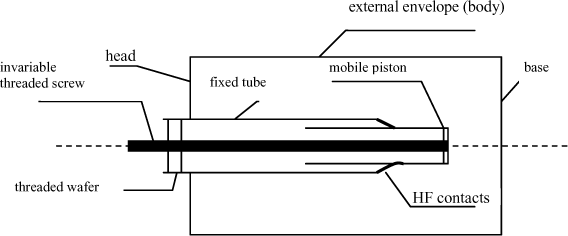Chapter 4
Fabrication and Tuning of Cavities
4.1. Standard structures
4.1.1. Band-pass
There are three main types of coaxial cavities: band-passes, rejects and pass-rejects. The specific features and the functions will be detailed later on; the basic architecture is the same for all three, and it is that of the band-pass cavity that is schematized in Figure 4.1.
Figure 4.1.

On the cavity body the head and the back are screwed or extruded. The electric continuity between the body and the back is less of a concern than that of the head, which must be perfect, with the body and the tube at the same time, and this is the reason why extrusion is always preferred to screwing. The mobile piston is the frequency regulating element; it is made accessible from the exterior by means of an invar rod which is blocked by a lock-nut or a more sophisticated device according to necessity (demultiplication, fine tuning, remotely-operated cavities, etc.). The usage of the invar is indispensable to assure frequency, but as a general rule it is not sufficient and must be associated with a mechanic compensation system making use of the intervention of several metals. It is obligatory for the head, the tube and the piston to be silver-plated so as to minimize the surface resistance. For the body and the back this is optional, and in fact it depends on the metal used and the intended performance levels. ...
Get VHF / UHF Filters and Multicouplers: Application of Air Resonators now with the O’Reilly learning platform.
O’Reilly members experience books, live events, courses curated by job role, and more from O’Reilly and nearly 200 top publishers.

